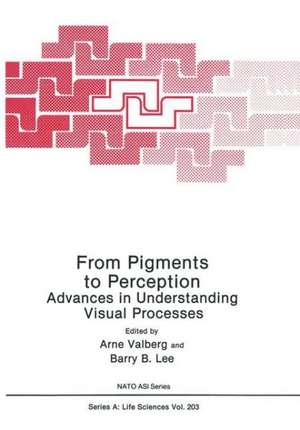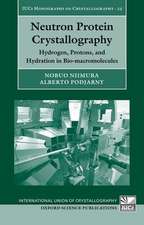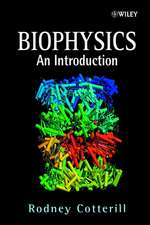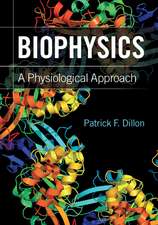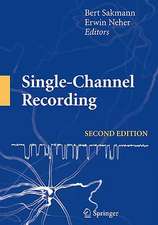From Pigments to Perception: Advances in Understanding Visual Processes: NATO Science Series A:, cartea 203
Editat de Arne Valberg, Barry B. Leeen Limba Engleză Paperback – noi 2012
Din seria NATO Science Series A:
- 15%
 Preț: 656.58 lei
Preț: 656.58 lei - 15%
 Preț: 655.13 lei
Preț: 655.13 lei - 15%
 Preț: 678.35 lei
Preț: 678.35 lei -
 Preț: 397.38 lei
Preț: 397.38 lei - 5%
 Preț: 377.87 lei
Preț: 377.87 lei -
 Preț: 397.76 lei
Preț: 397.76 lei - 18%
 Preț: 1232.41 lei
Preț: 1232.41 lei - 5%
 Preț: 731.64 lei
Preț: 731.64 lei -
 Preț: 413.15 lei
Preț: 413.15 lei - 15%
 Preț: 649.22 lei
Preț: 649.22 lei - 5%
 Preț: 369.45 lei
Preț: 369.45 lei -
 Preț: 407.56 lei
Preț: 407.56 lei - 5%
 Preț: 2162.19 lei
Preț: 2162.19 lei -
 Preț: 407.39 lei
Preț: 407.39 lei -
 Preț: 396.40 lei
Preț: 396.40 lei - 15%
 Preț: 663.93 lei
Preț: 663.93 lei -
 Preț: 387.38 lei
Preț: 387.38 lei -
 Preț: 393.13 lei
Preț: 393.13 lei -
 Preț: 398.35 lei
Preț: 398.35 lei -
 Preț: 401.24 lei
Preț: 401.24 lei - 15%
 Preț: 678.81 lei
Preț: 678.81 lei -
 Preț: 395.09 lei
Preț: 395.09 lei - 18%
 Preț: 952.40 lei
Preț: 952.40 lei - 15%
 Preț: 654.43 lei
Preț: 654.43 lei -
 Preț: 402.00 lei
Preț: 402.00 lei -
 Preț: 401.24 lei
Preț: 401.24 lei - 15%
 Preț: 655.27 lei
Preț: 655.27 lei -
 Preț: 394.71 lei
Preț: 394.71 lei -
 Preț: 384.48 lei
Preț: 384.48 lei - 5%
 Preț: 395.61 lei
Preț: 395.61 lei - 5%
 Preț: 1421.57 lei
Preț: 1421.57 lei - 15%
 Preț: 651.34 lei
Preț: 651.34 lei -
 Preț: 400.10 lei
Preț: 400.10 lei -
 Preț: 386.99 lei
Preț: 386.99 lei - 5%
 Preț: 386.11 lei
Preț: 386.11 lei -
 Preț: 403.91 lei
Preț: 403.91 lei - 15%
 Preț: 651.51 lei
Preț: 651.51 lei -
 Preț: 393.90 lei
Preț: 393.90 lei - 5%
 Preț: 376.43 lei
Preț: 376.43 lei -
 Preț: 400.26 lei
Preț: 400.26 lei - 5%
 Preț: 388.84 lei
Preț: 388.84 lei -
 Preț: 400.65 lei
Preț: 400.65 lei - 5%
 Preț: 740.58 lei
Preț: 740.58 lei - 18%
 Preț: 1225.16 lei
Preț: 1225.16 lei - 5%
 Preț: 386.46 lei
Preț: 386.46 lei -
 Preț: 421.82 lei
Preț: 421.82 lei
Preț: 407.19 lei
Nou
Puncte Express: 611
Preț estimativ în valută:
77.92€ • 80.86$ • 65.13£
77.92€ • 80.86$ • 65.13£
Carte tipărită la comandă
Livrare economică 15-29 martie
Preluare comenzi: 021 569.72.76
Specificații
ISBN-13: 9781461366546
ISBN-10: 1461366542
Pagini: 504
Ilustrații: XIII, 485 p.
Dimensiuni: 178 x 254 x 26 mm
Greutate: 0.87 kg
Ediția:Softcover reprint of the original 1st ed. 1991
Editura: Springer Us
Colecția Springer
Seria NATO Science Series A:
Locul publicării:New York, NY, United States
ISBN-10: 1461366542
Pagini: 504
Ilustrații: XIII, 485 p.
Dimensiuni: 178 x 254 x 26 mm
Greutate: 0.87 kg
Ediția:Softcover reprint of the original 1st ed. 1991
Editura: Springer Us
Colecția Springer
Seria NATO Science Series A:
Locul publicării:New York, NY, United States
Public țintă
ResearchCuprins
Biophysics and Psychophysics of Photoreceptors.- Visual Pigments and Colour Vision in Primates.- The Cost of Trichromaticity for Spatial Vision.- Variability in Cone Populations and Implications.- Discussion: Biophysics and Psychophysics of Photoreceptor.- Transition from Photopic to Scotopic Light Assessments and Possible Underlying Processes.- Dual Rod Pathways.- Wavelength-Discrimination with Only Rods and Blue Cones.- Density of Bipolar Cells in the Macaque Monkey Retina.- Discussion: Rod Vision.- Parvocellular and Magnocellular Pathways and Psychophysics.- Which Cells Code for Color?.- Receptive Field Structure of P and M Cells in the Monkey Retina.- On the Relation between Cellular Sensitivity and Psychophysical Detection.- P and M Pathway Specialization in the Macaque.- The Color-Opponent and Broad-band Channels of the Primate Visual System.- Discussion: P- and M-Pathways I.- Temporal Characteristics of Colour Vision: VEP and Psychophysical Measurements.- The Contribution of Colour to Motion.- Functional Classification of Parallel Pathways.- The Responses of Macaque Retinal Ganglion Cells to Complex Temporal Waveforms.- Remote Surrounds and the Sensitivity of Primate P-Cells.- On Neurophysiological Correlates of Simultaneous Colour and Brightness Contrast as Demonstrated in P-LGN-Cells of the Macaque.- Development of Infant Contrast Sensitivity and Acuity for Coloured Patterns.- Psychophysical Evidence of two Gradients of Neural Sampling in Peripheral Vision.- Discussion: P- and M-Pathways II.- Visual Evoked Potentials.- On the Nature of Visual Evoked Potentials, Unit Responses and Psychophysics.- Localization of the Electromagnetic Sources of the Pattern Onset Response in Man.- Discussion: Evoked Potentials.- Cortical Processing and Psychophysical Measurement.-Probing the Primate Visual Cortex: Pathways and Perspectives.- Lateral Interactions in Visual Cortex.- The Perceptual Significance of Cortical Organization.- Orientation and Spatial Frequency Selectivity: Properties and Modular Organization.- Orientation and Color Columns in Monkey Striate Cortex.- Discussion: Cortical Processing.- Psychophysical Studies and Post-Receptoral Processes.- Visual Photometry: Relating Psychophysics to some Aspects of Neurophysiology.- Sensory and Perceptual Processes in Seeing Brightness and Lightness.- Assimilation Versus Contrast.- On Achromatic Colors.- Color Opponency from Eye to Brain.- Chromatic Mechanisms beyond Linear Opponency.- Discussion: Psychophysics and Post-Receptoral Processes I.- Adaptation Mechanisms in Color and Brightness.- Testing the Contrast Explanation of Color Constancy.- Adaptation and Color Discrimination.- Studies on Colour Constancy in Man Using a “Checkerboard - Mondrian”.- Discussion: Post-Receptoral Processes II.- Models, Neural Processes and Psychophysics.- Origin of Perceptually Measured Phase Shifts in the Visual System.- Psychophysical Correlates of Parvo Channel Function.- On the Physiological Basis of Higher Colour Metrics.- Neural Decoding.- Effects of Phase Shifts between Cone Inputs on Responses of Chromatically Opponent Cells.- Different Neural Codes for Spatial Frequency and Contrast.- Displacement Estimation, Stereo Matching and ‘Object’ Recognition: A Computer Simulation Approach Working with Real World Imagery.- Scaling and Thresholds of Color and Light Described by an Opponent Model of Color Vision Based on Psychophysical Data.- Discussion: Models and Neural Nets.- General Discussion.- Participants.
